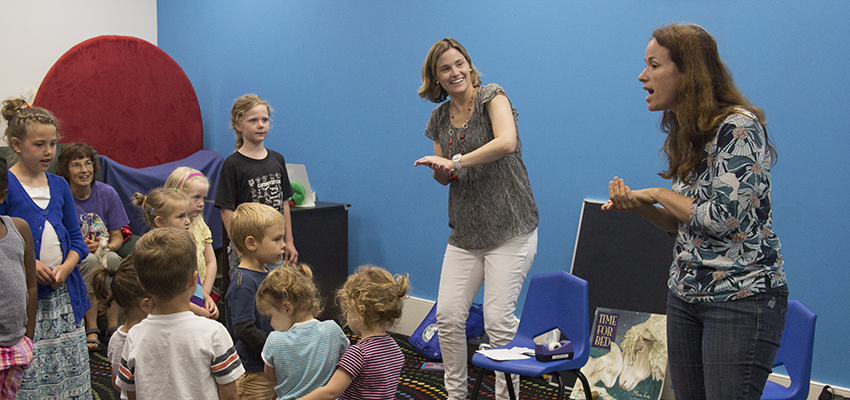
HWS News
18 August 2017 Building a Bilingual Geneva
Associate Professors of Spanish and Hispanic Studies May Farnsworth and Caroline Travalia hold a plastic dinosaur before 16 children at Geneva Public Library on a summer Tuesday morning. Some students are as young as two, but they know exactly what’s going on. “¿Es esto grande o pequeño?” Farnsworth asks. “¡Grande!” the children answer back.

Farnsworth and Travalia’s six-week summer program is a growing initiative dedicated to fostering foreign language in early education. Established by Farnsworth and the Geneva Public Library eight years ago, the course takes a communicative approach to teaching young children and their families Spanish, a mission that Farnsworth and Travalia embrace with no boundaries as volunteers. The professors led students in Spanish songs and activities, showing them that bailar means “to dance” in classes taught entirely without English.
“We try to make it fun and accessible to the kids. We learn our first language without knowing how to read, through repeated oral exposure to concrete references and eventually, imitation. We take the same approach in the program,” says Travalia, who also trains her HWS Spanish students to teach Spanish through children’s literature in Geneva. “We try to encourage them to actively engage with the material in different ways in each class. We keep the topics simple and clear and make sure to include a review at the beginning of each session so they are receiving multiple points of exposure to each concept.”
Through books, songs, improv and props, Farnsworth and Travalia present the topic of the day and have the kids apply what they’ve learned. “Getting them to move around the classroom, physically run to a particular station when the music stops, point out and transfer items from one location to another, etc., is key,” says Travalia. Activities where the kids have to paste images on the wall under the correct category or find a partner with a complementary concept were used to cover topics like colors, numbers, animals and parts of the body.
Demand for the program climbed to nearly 50 students enrolled this summer and additional teachers were welcomed to make it happen. “I think for me, it’s been a nice way to get to know families in the community because Spanish is something that people in this community want,” says Farnsworth. “It’s really nice to be able to share what we do at the Colleges with them.”
In 2009, Farnsworth was checking out Spanish language books for her daughter when she was approached by Tanya Taylor, the library’s assistant director and youth services coordinator. They soon launched the summer Spanish course, which began with four students and preceded bilingual education in Geneva schools. The popular program is now just one of 62 opportunities offered as part of the library’s Summer Reading Program.
“When a lot of people think of the Summer Reading Program, they think of sitting at home and just reading a book, but we do way more than that,” Taylor says. “Kids learn through fun. So if you love it during the process, you’re learning and you don’t even realize it. If you like it, you love it, you’re going to do it. And the kids and the parents love May and Caroline’s Spanish class.”
